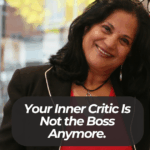Last month, I spent 10 days in complete silence. No talking. No phone. No validation. No distractions. Your emotional exhaustion – what’s it really trying to tell you?
Just me, my nervous system, and every single pattern I thought I’d outgrown. I went on a Vipassana meditation retreat. And what unravelled wasn’t what I expected. On the surface, I looked calm. But inside? I was cracking. And it wasn’t about the silence. It was what the silence made me feel.
Without roles to perform or screens to scroll… I met myself. Not the polished version. Not the “doing the work” version. The real one who still clenches when plans change, who spirals when there’s conflict, who flinches when the world feels too much.
What surfaced was this truth: I wasn’t exhausted from doing too much. I was exhausted from believing I wasn’t enough.
A Moment That Shook Me: Emotional Exhaustion
Shortly after I came back, I was out at a restaurant with a friend, laughing, feeling light and grounded. Then a waiter told us there were no tables available. He was abrupt. A little cold. And something in me snapped.
My mood flipped. My body tensed. And moments later, I found myself in a disagreement with my sister over the phone, edgy, reactive, and not myself.
Except… it was me. It was the part of me still operating from survival mode. Still interpreting small stress as a big threat. That wasn’t about the waiter. Or my sister.
That was about the internal pressure I hadn’t released.
The Pattern Beneath the Pattern
This is what I see in so many high-functioning women I work with:
✅ “I’m just tired.”
✅ “I’m just busy.”
✅ “It’s just a lot right now.”
But behind the “justs” is something deeper: A nervous system that learned chaos early—and never unlearned it.
We don’t randomly explode or shut down. We recreate what’s unresolved. And when your system was trained to spike and crash instead of regulate and flow, your body learns to live in a state of high alert.
What If It’s Not Mood Swings?
Let’s reframe something big:
You don’t have “anger issues.”
You don’t have “mood swings.”
You have a nervous system that was never taught to feel safe.
And unless we retrain it, the body will continue to interpret every unknown, every small disruption, as danger. This is why mindset alone doesn’t work.
Because when the body still feels unsafe, no amount of “thinking positively” can override it.
A Gentle Way In: The 3-Minute Reset
Here’s a straightforward technique I use when I feel the snap, the spiral, the shame creeping in:
🧘♀️ Sit. Place one hand on your chest, one on your belly.
🌬️ Inhale through your nose for 4 counts.
⏸️ Hold for 2.
😮💨 Exhale through your mouth for 6.
As you breathe, say: “I’m allowed to feel this. I’m safe to stay with myself.” This isn’t a hack. It’s a nervous system cue: We are not in danger right now. It’s subtle. Gentle. But this is how safety is built, one breath at a time.
Why This Work Matters Now
We are living through a time of collective stress. Grief, overwhelm, and disconnection are everywhere. But your body doesn’t distinguish between personal and global threats.
It only tracks safety. Which means the exhaustion you feel from “nothing in particular” might actually be your body’s response to everything.
This is why nervous system regulation isn’t a luxury. It can help with emotional exhaustion.
It’s leadership.
It’s legacy.
It’s healing that doesn’t just feel good, it changes everything
You don’t need more discipline.
You don’t need to “push through.”
You need permission to pause.
And a new way to feel safe being human.
That’s the work.
That’s the exhale.
And that’s what I teach inside Calm From the Inside Out.
Because the most powerful transformation isn’t in controlling life…emotional exhaustion can impact. It’s about creating a body that can feel safe within itself.
“It’s not your mood. It’s your wiring. And you can change it.”
Want to learn more Book a call






